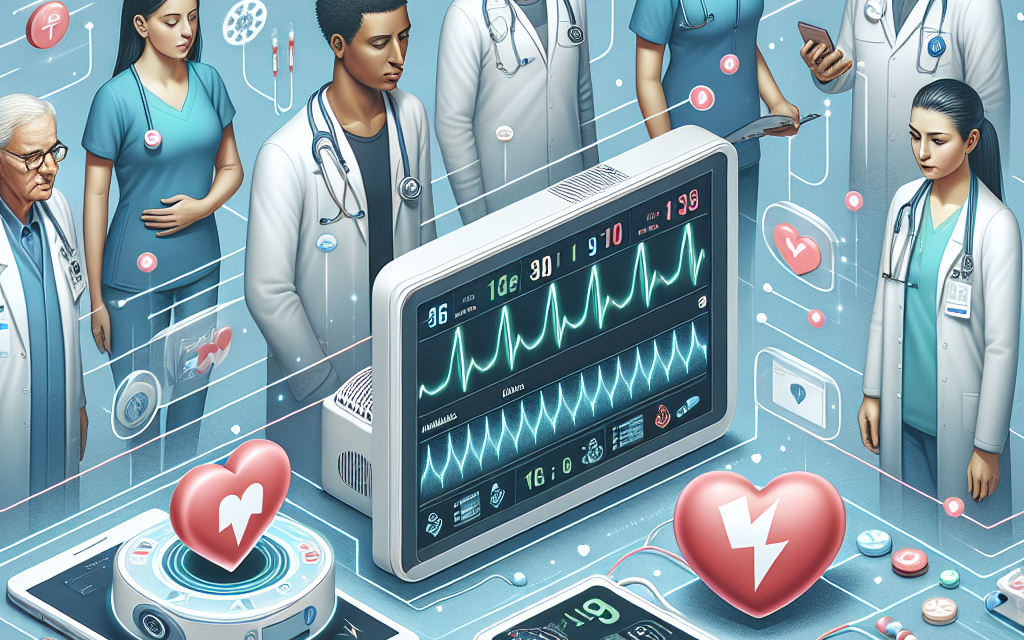Leveraging Technology to Minimize Medical Emergencies
In an era where technology permeates every aspect of our lives, the healthcare sector is no exception. The integration of advanced technologies into medical practices has the potential to significantly reduce the frequency and severity of medical emergencies. This article explores various technological innovations that are transforming emergency medical care, enhancing patient outcomes, and ultimately saving lives. We will delve into five key areas: telemedicine, wearable health technology, artificial intelligence in diagnostics, mobile health applications, and data analytics in emergency response.
Telemedicine: Bridging the Gap in Emergency Care
Telemedicine has emerged as a revolutionary tool in healthcare, particularly in emergency situations. By allowing patients to consult healthcare professionals remotely, telemedicine minimizes delays in treatment and enhances access to care.
One of the most significant advantages of telemedicine is its ability to provide immediate medical advice. In emergencies, every second counts. Telemedicine platforms enable patients to connect with doctors via video calls, phone calls, or chat, allowing for quick assessments and recommendations. For instance, during the COVID-19 pandemic, many hospitals adopted telemedicine to manage patient flow and reduce the risk of virus transmission. According to a report by McKinsey, telehealth utilization has stabilized at levels 38 times higher than before the pandemic.
Moreover, telemedicine can be particularly beneficial in rural or underserved areas where access to emergency care is limited. Patients can receive timely consultations without the need to travel long distances, which can be critical in life-threatening situations. For example, a study published in the Journal of Telemedicine and Telecare found that telemedicine consultations for stroke patients led to faster treatment times and improved outcomes.
However, the effectiveness of telemedicine in emergencies is contingent upon several factors:
- Technology Access: Patients must have access to reliable internet and devices capable of supporting telemedicine platforms.
- Training for Healthcare Providers: Medical professionals need training to effectively use telemedicine tools and protocols.
- Regulatory Framework: Policies must be in place to ensure that telemedicine practices comply with healthcare regulations and standards.
In conclusion, telemedicine is a powerful tool that can minimize medical emergencies by providing immediate access to healthcare professionals, especially in remote areas. As technology continues to evolve, the potential for telemedicine to enhance emergency care will only grow.
Wearable Health Technology: Monitoring and Prevention
Wearable health technology, such as smartwatches and fitness trackers, has gained immense popularity in recent years. These devices not only track physical activity but also monitor vital signs, providing users with real-time health data that can be crucial in preventing medical emergencies.
One of the most significant advancements in wearable technology is the ability to monitor heart rate, blood pressure, and even blood oxygen levels. For instance, the Apple Watch has features that can detect irregular heart rhythms and alert users to potential atrial fibrillation, a condition that can lead to stroke if left untreated. A study published in the Journal of the American College of Cardiology found that wearable devices could accurately detect atrial fibrillation in 97% of cases.
Additionally, wearables can track physical activity and sleep patterns, providing insights into overall health. By encouraging users to maintain a healthy lifestyle, these devices can help prevent conditions such as obesity, diabetes, and hypertension, which are often precursors to medical emergencies.
Wearable technology also plays a crucial role in chronic disease management. For patients with conditions like diabetes, continuous glucose monitors (CGMs) provide real-time data on blood sugar levels, allowing for timely interventions. A study published in Diabetes Technology & Therapeutics found that CGMs significantly reduced the incidence of severe hypoglycemia in patients with type 1 diabetes.
However, the effectiveness of wearable health technology in minimizing medical emergencies depends on:
- User Engagement: Users must be motivated to wear the devices consistently and act on the data provided.
- Data Accuracy: The reliability of the data collected by wearables is crucial for effective monitoring and intervention.
- Integration with Healthcare Systems: Wearable data should be integrated into electronic health records (EHRs) to provide healthcare providers with comprehensive patient information.
In summary, wearable health technology has the potential to minimize medical emergencies by enabling proactive health monitoring and encouraging healthier lifestyles. As these devices become more sophisticated, their role in emergency prevention will continue to expand.
Artificial Intelligence in Diagnostics: Enhancing Decision-Making
Artificial intelligence (AI) is transforming the healthcare landscape, particularly in diagnostics. By analyzing vast amounts of data, AI can assist healthcare professionals in making more accurate and timely decisions, ultimately reducing the likelihood of medical emergencies.
AI algorithms can analyze medical images, such as X-rays, MRIs, and CT scans, with remarkable accuracy. For example, a study published in Nature found that an AI system developed by Google Health outperformed radiologists in detecting breast cancer in mammograms. The AI system reduced false positives by 5.7% and false negatives by 9.4%, leading to earlier and more accurate diagnoses.
Moreover, AI can analyze patient data to identify risk factors for various conditions. Machine learning models can predict the likelihood of heart attacks, strokes, and other emergencies based on a patient’s medical history, lifestyle, and genetic factors. For instance, a study published in the Journal of the American Heart Association demonstrated that an AI model could predict cardiovascular events with 80% accuracy, allowing for early interventions.
AI can also streamline the triage process in emergency departments. By analyzing patient symptoms and vital signs, AI systems can prioritize cases based on severity, ensuring that critical patients receive immediate attention. A pilot program at a major hospital in the United States found that an AI-driven triage system reduced wait times for high-risk patients by 30%.
However, the integration of AI in diagnostics comes with challenges:
- Data Privacy: The use of patient data for AI training raises concerns about privacy and security.
- Bias in Algorithms: AI systems can perpetuate existing biases if trained on non-representative data.
- Acceptance by Healthcare Professionals: There may be resistance from healthcare providers who are skeptical about relying on AI for critical decisions.
In conclusion, AI has the potential to revolutionize diagnostics in healthcare, enhancing decision-making and reducing the incidence of medical emergencies. As technology continues to advance, the integration of AI into clinical practice will become increasingly vital.
Mobile Health Applications: Empowering Patients
Mobile health applications (mHealth apps) have become an integral part of modern healthcare, empowering patients to take control of their health and well-being. These applications provide users with tools to monitor their health, access medical information, and communicate with healthcare providers, all of which can help minimize medical emergencies.
One of the primary benefits of mHealth apps is their ability to facilitate self-monitoring. For instance, apps that track medication adherence can remind patients to take their medications on time, reducing the risk of complications from missed doses. A study published in the Journal of Medical Internet Research found that patients using medication reminder apps had a 30% higher adherence rate compared to those who did not use such tools.
Additionally, mHealth apps can provide users with personalized health information and resources. For example, apps that offer symptom checkers can help users assess their conditions and determine whether they need to seek medical attention. This can be particularly useful in emergency situations where quick decision-making is crucial. A study published in the British Medical Journal found that symptom checker apps could accurately triage patients in 80% of cases.
Furthermore, mHealth apps can enhance communication between patients and healthcare providers. Many apps allow users to send messages, share health data, and schedule appointments, making it easier for patients to access care when needed. A survey conducted by the Pew Research Center found that 64% of smartphone owners use health-related apps, indicating a growing trend toward digital health management.
However, the effectiveness of mHealth apps in minimizing medical emergencies depends on several factors:
- User Engagement: Patients must be motivated to use the apps regularly and follow the recommendations provided.
- Data Security: Ensuring the privacy and security of patient data is crucial for building trust in mHealth applications.
- Integration with Healthcare Systems: mHealth apps should be integrated with EHRs to provide healthcare providers with comprehensive patient information.
In summary, mobile health applications empower patients to take charge of their health, facilitating self-monitoring and improving communication with healthcare providers. As the adoption of mHealth apps continues to grow, their role in minimizing medical emergencies will become increasingly significant.
Data Analytics in Emergency Response: Optimizing Resource Allocation
Data analytics plays a crucial role in optimizing emergency response systems, enabling healthcare providers to allocate resources more effectively and respond to emergencies more efficiently. By analyzing data from various sources, emergency services can identify trends, predict demand, and improve overall response times.
One of the key applications of data analytics in emergency response is predictive modeling. By analyzing historical data on emergency calls, response times, and patient outcomes, emergency services can forecast demand and allocate resources accordingly. For example, a study conducted by the University of California, Los Angeles (UCLA) found that predictive analytics could improve ambulance response times by 20% by optimizing dispatch strategies.
Moreover, data analytics can enhance situational awareness during emergencies. Real-time data from various sources, such as traffic patterns, weather conditions, and hospital capacity, can be analyzed to inform decision-making. For instance, during natural disasters, data analytics can help emergency services identify areas most in need of assistance and deploy resources accordingly.
Additionally, data analytics can improve training and preparedness for emergency responders. By analyzing past incidents, emergency services can identify areas for improvement and develop targeted training programs. A study published in the International Journal of Emergency Services found that data-driven training programs significantly improved the performance of emergency responders during simulated emergencies.
However, the effective use of data analytics in emergency response faces several challenges:
- Data Integration: Combining data from multiple sources can be complex and requires robust systems.
- Data Quality: The accuracy and reliability of data are crucial for effective analysis and decision-making.
- Privacy Concerns: The use of personal data for analytics raises ethical and legal considerations.
In conclusion, data analytics is a powerful tool for optimizing emergency response systems, enabling healthcare providers to allocate resources effectively and improve response times. As technology continues to advance, the potential for data analytics to enhance emergency care will only grow.
Conclusion
In summary, leveraging technology to minimize medical emergencies is a multifaceted approach that encompasses telemedicine, wearable health technology, artificial intelligence, mobile health applications, and data analytics. Each of these areas offers unique benefits and challenges, but together they represent a significant advancement in emergency medical care.
As we continue to embrace technological innovations in healthcare, it is essential to address the challenges associated with their implementation. Ensuring access to technology, maintaining data privacy, and fostering collaboration between patients and healthcare providers are critical steps toward maximizing the potential of these tools.
Ultimately, the integration of technology into emergency medical care has the potential to save lives, improve patient outcomes, and create a more efficient healthcare system. By continuing to invest in and develop these technologies, we can work towards a future where medical emergencies are minimized, and patients receive the timely care they need.





